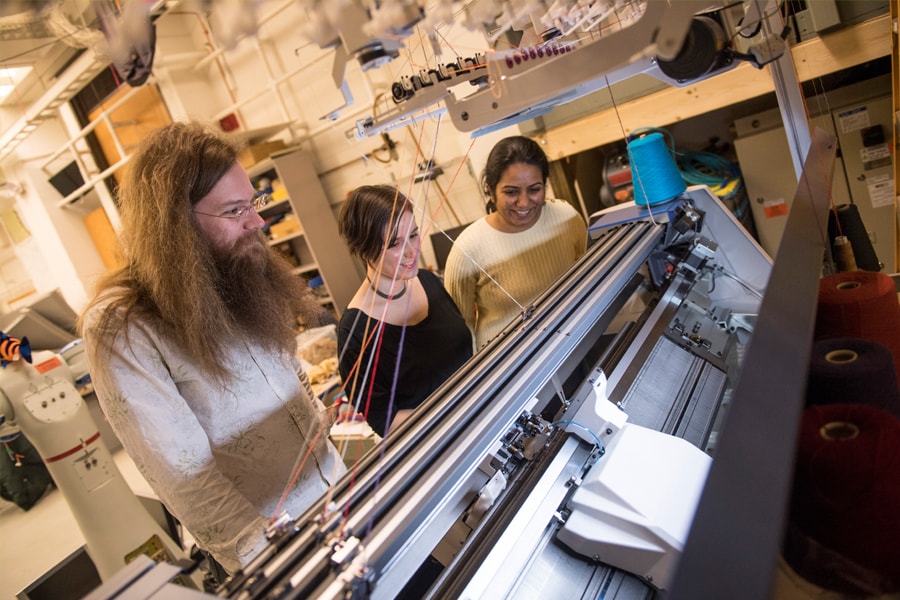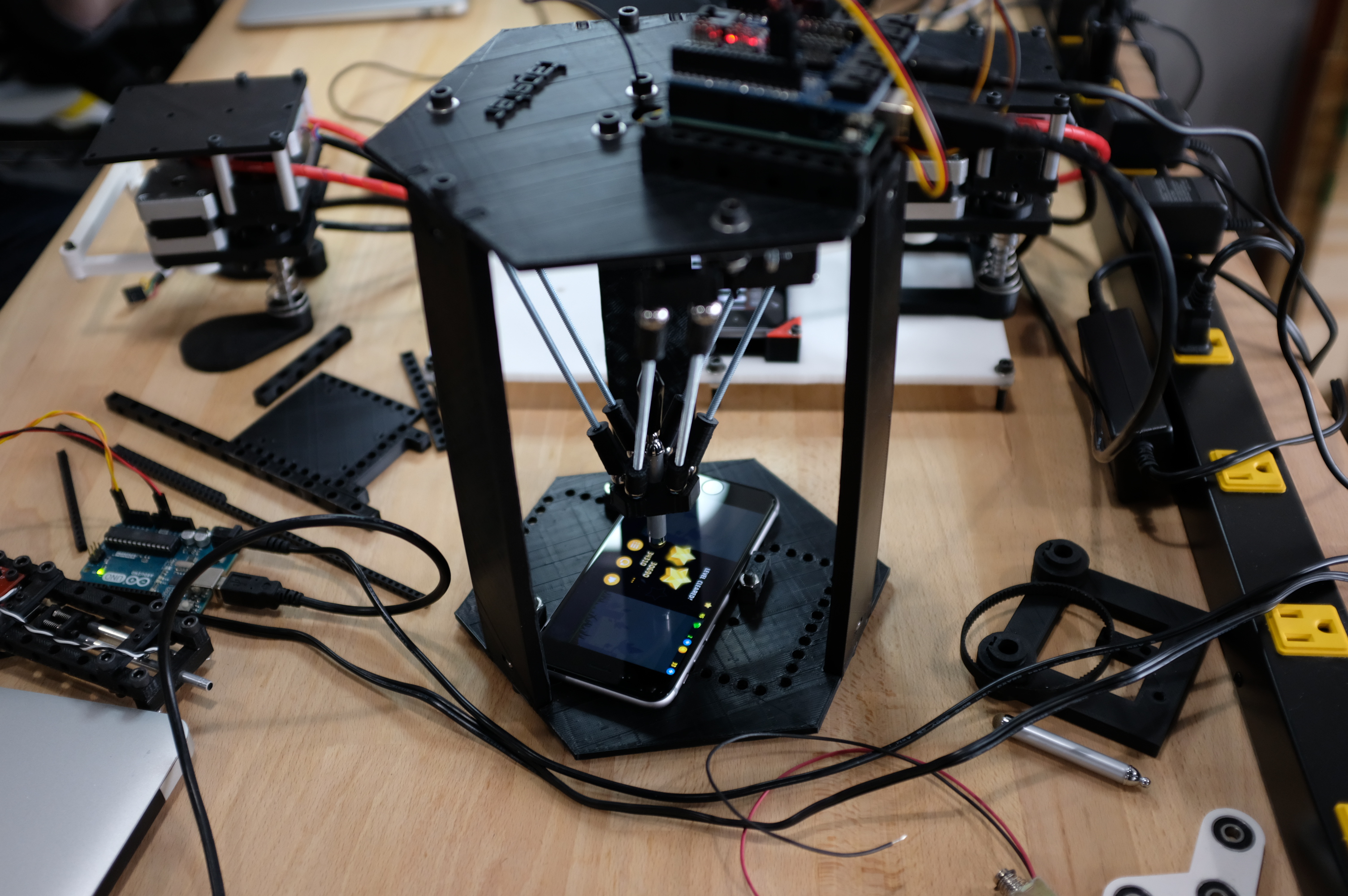
By AMY SULLIVAN from NYT Opinion https://ift.tt/2uGe76k







At last, a use for that industrial knitting machine you bought at a yard sale! Carnegie Mellon researchers have created a method that generates knitting patterns for arbitrary 3D shapes, opening the possibility of “on-demand knitting.” Think 3D printing, but softer.
The idea is actually quite compelling for those of us who are picky about their knitwear. How often have we picked up a knit cap, glove, or scarf only to find it too long, too short, too tight, too loose, etc?
If you fed your sartorial requirements (a 3D mesh) into this system from James McCann and students at CMU’s Textiles Lab, it could quickly spit out a pattern that a knitting machine could follow easily yet is perfectly suited for your purposes.
 This has to be done carefully — the machines aren’t the same as human knitters, obviously, and a poorly configured pattern might lead to yarn breaking or jamming the machine. But it’s a lot better than having to build that pattern purl by purl.
This has to be done carefully — the machines aren’t the same as human knitters, obviously, and a poorly configured pattern might lead to yarn breaking or jamming the machine. But it’s a lot better than having to build that pattern purl by purl.
With a little more work, “Knitting machines could become as easy to use as 3D printers,” McCann said in a CMU news release.
Of course, it’s unlikely you’ll have one of your own. But maker spaces and designer ateliers (I believe that’s the term) will be more likely to if it’s this easy to create new and perfectly sized garments with them.
McCann and his team will be presenting their research at SIGGRAPH this summer.



When Facebook loses, who wins?
That’s a question for startups that may be worth contemplating following Facebook’s recent stock price haircut. The company’s valuation has fallen by around $60 billion since the Cambridge Analytica scandal surfaced earlier this month and the #DeleteFacebook campaign gained momentum.
That’s a steep drop, equal to about 12 percent of the company’s market valuation, and it’s a decline Facebook appears to be suffering alone. As its shares fell over the past couple of weeks, stocks of other large-cap tech and online media companies have been much flatter.
So where did the money go? It’s probably a matter of perspective. For a Facebook shareholder, that valuation is simply gone. And until executives’ apologies resonate and users’ desire to click and scroll overcomes their privacy fears, that’s how it is.
An alternate view is that the valuation didn’t exactly disappear. Investors may still believe the broad social media space is just as valuable as it was a couple of weeks ago. It’s just that less of that pie should be the exclusive domain of Facebook.
If one takes that second notion, then the possibilities for who could benefit from Facebook’s travails start to get interesting. Of course, there are public market companies, like Snap or Twitter, that might pick up traffic if the #DeleteFacebook movement gains momentum without spreading to other big brands. But it’s in the private markets where we see the highest number of potential beneficiaries of Facebook’s problems.
In an effort to come up with some names, we searched through Crunchbase for companies in social media and related areas. The resulting list includes companies that have raised good-sized rounds in the past couple of years and could conceivably see gains if people cut back on using Facebook or owning its stock.
Of course, people use Facebook for different things (posting photos, getting news, chatting with friends and so on), so we lay out a few categories of potential beneficiaries of a Facebook backlash.
Facebook has a significant messaging presence, but it hasn’t been declared the winner. Alternatives like Snap, LINE, WeChat and plain old text messages are also massively popular.
That said, what’s bad for Messenger and Facebook-owned WhatsApp is probably good for competitors. And if more people want to do less of their messaging on Facebook, it helps that there are a number of private companies ready to take its place.
Crunchbase identified six well-funded messaging apps that could fit the bill (see list). Collectively, they’ve raised well over $2 billion — if one includes the $850 million initial coin offering by Telegram.
Increasingly, these private messaging startups are focused on privacy and security, including Wickr, the encrypted messaging tool that has raised more than $70 million, and Silent Circle, another encrypted communications provider that has raised $130 million.
People who cut back on Facebook may still want to spend hours a day staring at posts on a screen. So it’s likely they’ll start staring at something else that’s content-rich, easy-to-navigate and somewhat addictive.
Luckily, there are plenty of venture-backed companies that fit that description. Many of these are quite mature at this point, including Pinterest for image collections, Reddit for post and comment threads and Quora for Q&A (see list).
Granted, these will not replace the posts keeping you up to date on the life events of family and friends. But they could be a substitute for news feeds, meme shares and other non-personal posts.
A decline in Facebook usage could translate into a rise in traffic for a host of niche content and discussion platforms focused on sports, celebrities, social issues and other subjects.
Crunchbase News identified at least a half-dozen that have raised funding in recent quarters, which is just a sampling of the total universe. Selected startups run the gamut from The Players’ Tribune, which features first-hand accounts for top athletes, to Medium, which seeks out articles that resonate with a wide audience.
Niche sites also provide a more customized forum for celebrities, pundits and subject-matter experts to engage directly with fans and followers.
People with common interests don’t have to share them on Facebook. There are other places that can offer more tailored content and social engagement.
In recent years, we’ve seen an increase in community and activity-focused social apps gain traction. Perhaps the most prominent is Nextdoor, which connects neighbors for everything from garage sales to crime reports. We’re also seeing some upstarts focused on creating social networks for interest groups. These include Mighty Networks and Amino Apps.
Though some might call it a stretch, we also added to the list WeWork, recent acquirer of Meetup, and The Guild, two companies building social networks in the physical world. These companies are encouraging people to come out and socially network with other people (even if just means sitting in a room with other people staring at a screen).
Facebook’s latest imbroglio is still too recent to expect a visible impact in the startup funding arena. But it will be interesting to watch in the coming months whether potential rivals in the above categories raise a lot more cash and attract more users.
If there’s demand, there’s certainly no shortage of supply on the investor front. The IPO window is wide open, and venture investors are sitting on record piles of dry powder. It hasn’t escaped notice, either, that social media offerings, like Facebook, LinkedIn and Snap, have generated the biggest exit total of any VC-funded sector.
Moreover, those who’ve argued that it’s too late for newcomers have a history of being proven wrong. After all, that’s what people were saying about would-be competitors to MySpace in 2005, not long before Facebook made it big.
The Red Hat Linux distribution is turning 25 years old this week. What started as one of the earliest Linux distributions is now the most successful open-source company, and its success was a catalyst for others to follow its model. Today’s open-source world is very different from those heady days in the mid-1990s when Linux looked to be challenging Microsoft’s dominance on the desktop, but Red Hat is still going strong.
To put all of this into perspective, I sat down with the company’s current CEO (and former Delta Air Lines COO) Jim Whitehurst to talk about the past, present and future of the company, and open-source software in general. Whitehurst took the Red Hat CEO position 10 years ago, so while he wasn’t there in the earliest days, he definitely witnessed the evolution of open source in the enterprise, which is now more widespread than every.
“Ten years ago, open source at the time was really focused on offering viable alternatives to traditional software,” he told me. “We were selling layers of technology to replace existing technology. […] At the time, it was open source showing that we can build open-source tech at lower cost. The value proposition was that it was cheaper.”
At the time, he argues, the market was about replacing Windows with Linux or IBM’s WebSphere with JBoss. And that defined Red Hat’s role in the ecosystem, too, which was less about technological information than about packaging. “For Red Hat, we started off taking these open-source projects and making them usable for traditional enterprises,” said Whitehurst.
About five or six ago, something changed, though. Large corporations, including Google and Facebook, started open sourcing their own projects because they didn’t look at some of the infrastructure technologies they opened up as competitive advantages. Instead, having them out in the open allowed them to profit from the ecosystems that formed around that. “The biggest part is it’s not just Google and Facebook finding religion,” said Whitehurst. “The social tech around open source made it easy to make projects happen. Companies got credit for that.”
He also noted that developers now look at their open-source contributions as part of their resumé. With an increasingly mobile workforce that regularly moves between jobs, companies that want to compete for talent are almost forced to open source at least some of the technologies that don’t give them a competitive advantage.
As the open-source ecosystem evolved, so did Red Hat. As enterprises started to understand the value of open source (and stopped being afraid of it), Red Hat shifted from simply talking to potential customers about savings to how open source can help them drive innovation. “We’ve gone from being commeditizers to being innovators. The tech we are driving is now driving net new innovation,” explained Whitehurst. “We are now not going in to talk about saving money but to help drive innovation inside a company.”
Over the last few years, that included making acquisitions to help drive this innovation. In 2015, Red Hat bought IT automation service Ansible, for example, and last month, the company closed its acquisition of CoreOS, one of the larger independent players in the Kubernetes container ecosystem — all while staying true to its open-source root.
There is only so much innovation you can do around a Linux distribution, though, and as a public company, Red Hat also had to look beyond that core business and build on it to better serve its customers. In part, that’s what drove the company to launch services like OpenShift, for example, a container platform that sits on top of Red Hat Enterprise Linux and — not unlike the original Linux distribution — integrates technologies like Docker and Kubernetes and makes them more easily usable inside an enterprise.
The reason for that? “I believe that containers will be the primary way that applications will be built, deployed and managed,” he told me, and argued that his company, especially after the CoreOS acquisition, is now a leader in both containers and Kubernetes. “When you think about the importance of containers to the future of IT, it’s a clear value for us and for our customers.”
The other major open-source project Red Hat is betting on is OpenStack. That may come as a bit of a surprise, given that popular opinion in the last year or so has shifted against the massive project that wants to give enterprises an open source on-premise alternative to AWS and other cloud providers. “There was a sense among big enterprise tech companies that OpenStack was going to be their savior from Amazon,” Whitehurst said. “But even OpenStack, flawlessly executed, put you where Amazon was five years ago. If you’re Cisco or HP or any of those big OEMs, you’ll say that OpenStack was a disappointment. But from our view as a software company, we are seeing good traction.”
Because OpenStack is especially popular among telcos, Whitehurst believes it will play a major role in the shift to 5G. “When we are talking to telcos, […] we are very confident that OpenStack will be the platform for 5G rollouts.”
With OpenShift and OpenStack, Red Hat believes that it has covered both the future of application development and the infrastructure on which those applications will run. Looking a bit further ahead, though, Whitehurst also noted that the company is starting to look at how it can use artificial intelligence and machine learning to make its own products smarter and more secure, but also at how it can use its technologies to enable edge computing. “Now that large enterprises are also contributing to open source, we have a virtually unlimited amount of material to bring our knowledge to,” he said.

Since persistently smearing former FBI director James Comey has not moved him to appear on Sean Hannity’s television and/or radio show, Hannity is now framing it as Comey’s patriotic obligation.
Comey has a number of sure-to-be-blockbuster interviews scheduled as part of an upcoming book tour. Hannity must be burning up with jealousy knowing the high ratings that everyone he hates will get when Comey appears on their shows: Rachel Maddow, Stephen Colbert, Anderson Cooper and George Stephanopoulos, e.g. It must be especially galling for Hannity given that he is regularly losing to Maddow in the ratings these days.


At some point in the not-so-distant past, April Fools was about pranks and hoaxes, but given that we apparently have enough of those on the web, the day has somehow morphed into a celebration of random jokey things. This year’s Google Maps gag is no exception.
Starting today, when you open Google Maps on your phone or desktop, you’ll see Waldo in his trademark red and white sweater, waving at you you from the side of your screen. That’s because Waldo is sharing his location with you for the next few days and he really wants to be found (or not… I’m never quite sure about what Waldo’s real motivations are…). You can also ask the Google Assistant “Hey Google. Where’s Waldo?”
Then, when you click on Waldo in the map, you get to see a standard “Where is Waldo” image and your job is to find him, as well as Woof, Wenda, Wizard Whitebeard and Odlaw.
Now if Google had wanted to make this a real April Fools joke, it would’ve announced this and then never released it or just shown you a standard “Where is Waldo” image without Waldo. That way, it would’ve driven everybody mad. But I’m pretty sure it’s for real, so head over to Google Maps and give it a try.

The CEO and COO are at their desks when I knock on the door, intently assembling robots to fulfill the company’s latest order. Tapster is about as lean as startups get. Founded three years ago (on Star Wars Day), the company’s two-person staff is half the size it was at its height, but a third employee moved on, and the fourth was more of an intern, really.
It’s a humble operation headquartered in nondescript strip of stores in Oakpark, a quiet suburban village just outside of Chicago. Inside, a row of desktop 3D printers churn away on the products. Pieces of future robots are strewn about the desks, pulled from nearby shelves stocked with bins full of parts.
To their right, crumbling wooden prototypes stand as a kind of museum to the humble company’s even humbler origins. An accidental startup of sorts, Tapster formed was while Jason Huggins was working as CTO of his previous company, Sauce Labs — a Selenium testing startup.
Burned out from software, the story goes, he enrolled in a laser cutting class at bygone maker space chain, Tech Shop. With those newfound skills, he built a button-clicking robot, and then, eventually, one capable of playing Angry Birds — all the rage back in 2011.The project gave Huggins a smalll YouTube hit and earned him speaking gigs at various tech conferences.
It also managed to grab the attention of a Mercedes Benz. The luxury car maker was searching for an automated device to help test a self-parking app on its in-car touchscreen displays.
“They got a price quote from an industrial robotics company, and the quote was about $100,000,” says Huggins. “They have lots of money and they could have bought it, but they had to get like ten of them. The traditional robotics market is buying one big machine to do something precisely. We’re coming in and making the robots cheaper, so you can buy more of them.”
A few months prior to officially founding the company, Huggins began work on his order for the car maker — 10 small robots designed to automate the testing of touchscreens by repeatedly and systematically tapping the hell out of them.
“Right before they found us, they were going to buy a LEGO Mindstorm kit and have two engineers work on it for five of six months and figure out what they could come up with,” Huggins adds. “Often our competition is do-it-yourself. They’re trying to bubblegum and duct tape something together.”

Granted, Tapster’s own processes aren’t too far removed. Huggins is a former Google Tester who’s become something of a full-time tinkerer, building robots from LEGO kits and self-modeled 3D printed parts. He’s shows me a prototype of the company’s latest robot, which stands of a pair of Ronald McDonald feet.
“I couldn’t find clown shoes on Thingiverse,” he tells me, excitedly. “So I made them. If you look up ‘Clown Shoes,’ you’ll find mine.”
These sorts of automated robotics are common for hardware manufacturers looking to test touchscreens. And while Tapster’s offerings are admittedly less sophisticated that the single service industrial robotics being deployed by larger organizations, Tapster is able to deliver their highly specialized product for a fraction of the cost.

Huggins hopes to one day make Tapster the go-to product for automated touchscreen testing, but for now, it’s baby steps. To date, the startup has functioned on a combination of self-funding, product sales and $100,000 in backing from Indie.vc, a micro venture firm that invests in, “Real businesses want to stay in business, not run for the exit.”
“This is my second startup, and I’m really intentional about bootstrapping for as long as possible,” says Huggins. “I’m not anti-VC, but I’m definitely pro-having leverage. When you can walk in there say, ‘this is a train leaving the station and money can accelerate these trend lines,’ I’d like to be in that situation. That means I have to do more things longer. I’m not going out there and raising a seed round and hiring. I want to have a solid business I can hire into.”










Why was the boycott against Laura Ingraham's show so swift and successful?
Because Laura Ingraham's brand is bullying, and everybody knew it.
That's the thing about Laura Ingraham: bullying is her >>brand<<. https://t.co/lkuPCzjQND
— Frances Langum (@bluegal) March 29, 2018
And anyone who ever bought time on her show knows it.
— driftglass (@Mr_Electrico) March 30, 2018
It's only that David Hogg, Parkland shooting survivor, was willing to point at the emperor and say naked.
And for once, cable news seems willing to point at one of their own (and don't deny it, MSNBC, we've got Keith Olbermann's receipts in hand and Ingraham was an MSNBC employee in the 90's) and remember the history of Ingraham's abuses. Partial transcript via Media Matters:




We made it to Saturday, Crooks and Liars! The long reach of your boss cannot touch us now, but as we report today, the long reach of the law can get to a certain fugitive from 1600 Pennsylvania Ave. currently thought to be hiding out at Merde-a-Lardo.
Zander Versus the Stupid says that it's Mueller Time. Make mine a double!
Trump Time Stamp explains the latest updates in Comrade Trump's pending lawsuits for violation of the Emoluments Clause of the Constitution.
Juanity Jean's looks at Obstruction of Justice and how it doesn't seem to apply to lawyers inside the Beltway.
Rubber Hose tells us why it would be easier to get a lawyer for a banana republic dictator than for Prznint Stupid.
Bonus Track: The Guardian has an interview with Kier Dullea, who play the astronaut Dave Bowman in Staley Kubrick's 2001: A Space Odyssey. Amongst many of the revelations is how Kubrick managed to simulate centrifugal force in the movie, way before CGI effects were a thing. If you are obsessed with Kubrick (Guilty, as charged), this is a treasure of a read.

“Snowpocalypse.” “Robo-apocalypse.” “Retail apocalypse.”
Casual references to annihilation pop up every day in American life. That makes it harder to communicate the danger posed by Donald Trump’s appointment of John Bolton as National Security Advisor.
Bolton has poor judgment, a mean spirit, and an intellect that’s weaker than he thinks. He spreads ethnic hatred and argues for sending others to fight and die.

Photo credit: Gage Skidmore / flickr
This weekend, young people around the country stood up against gun violence in their schools. Bolton’s appointment tells us that senseless violence may soon dominate our foreign policy, too, even more than it already does.
Bolton seems to pursue Machiavelli’s dictum that “it is much safer to be feared than loved.” But it’s not safer. As we’ve learned from Bolton’s past mistakes, foolish wars bring fresh dangers as well as needless tragedies.
Machiavelli also said, “The first method for estimating the intelligence of a ruler is to look at the men he has around him.” This appointment confirms what many of us already thought about Trump’s intelligence.
But Bolton’s no Trumpian deviation from social or political norms. He’s a political insider, beloved by think-tankers and mainstream media outlets alike. They’re already clucking their tongues in disapproval at Bolton’s appointment, but it’s all for show.
Bolton’s one of them.


Ingraham told viewers she was taking a pre-planned vacation around the Easter holiday, but worked Good Friday. Uh huh....
Source: Variety
Laura Ingraham is taking avacation next week. Now the question is whether a controversy swirling around the host will go on hiatus as well.
The popular Fox News Channel host – her “Ingraham Angle” was the fourth most-watched cable-news program in February – told viewers Friday night she would not appear on air next week as she took what she described as a pre-planned break around the Easter holiday with her children. Substitute hosts are expected to fill in for her on the program.
from Latest from Crooks and Liars
via Click me for Details






